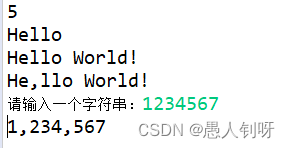声明:基于之前的代码 这里只编写核心业务
求单链表中有效结点的个数
这里判断的是有头结点的链表。
/**
* 获取链表有效结点个数 (这里的链表是有头结点的)
* @param head 传入头结点就相当于传入的单链表
* @return 有效结点个数
*/
public static int getLength(HeroNode head){
if (head.next == null){
return 0;
}
HeroNode cur = head; // 拷贝head,head不能动
int length = 0;
while (true){
if (cur.next == null){
break;
}
cur = cur.next;
length++;
}
return length;
}
查找单链表中倒数第n个结点
/**
* 查找单链表中倒数第n个结点
*
* @param head 头结点
* @param n 倒数第一个元素
* @return 返回结点
* <p>
* 思路
* 1. 遍历一遍获得链表的总长度getLength
* 2. 得到长度后遍历(length-n+1)个结点得到的就是
* 3. 如果没有找到返回null
*/
public static HeroNode getLastIndexNode(HeroNode head, int n) {
//链表为空返回null
if (head.next == null) {
return null;
}
int length = getLength(head);//在这个方法中已经完成了一次遍历
//判断这个n是否存在
if (n < 0 || n > length) {
return null;//根本找不到
}
HeroNode cur = head.next;
for (int i = 0; i < (length - n); ++i) {
cur = cur.next;
}
return cur;
}
单链表的反转
import java.util.Stack;//使用栈需要引入包
/**
* 反转链表
* @param head 传入头结点;
* 思路
* 1. 创建一个新的链表
* 2. 每遍历一个原链表结点将遍历的结点的next保存
* 3. 将被遍历结点插入到新链表的head.next结点上
*/
public static void reverseList(HeroNode head){
//不需要反转的情况: 没有结点或者只有一个结点
if (head.next == null || head.next.next == null){
return;
}
HeroNode reverseHead = new HeroNode(0,"","");
//定义辅助指针即备份变量
HeroNode cur = head.next;
HeroNode next = null;//存放思路中的2
//这里的顺序特别的重要
// 在纸上画出草图 注意需要存储的结点及表达
while (cur != null){
next = cur.next;
cur.next = reverseHead.next;
reverseHead.next = cur;
cur = next;
}
head.next = reverseHead.next;
}
从尾到头打印单链表
/**
* 从尾到头打印单链表
* 方式1:反向遍历 即先反转 后打印
* 但是这样破坏了原来的链表结构。
* 方式2:使用栈 Stack
* 将每个结点压入栈中然后弹栈 利用了栈的先进后出的思想
*/
public static void reversePrintByStack(HeroNode head){
//如果为空 打印这是空链表
if (head.next == null){
System.out.println("这个链表是空的");
return;
}
//creat a stack, push each node onto that.
Stack<HeroNode> heroNodes = new Stack<>();
HeroNode cur = head.next;
while (cur != null){
heroNodes.push(cur);
cur = cur.next;
}
while (heroNodes.size()>0){
System.out.println(heroNodes.pop());
}
}
合并两个单链表,合并后的单链表仍然有序
public static HeroNode margeLinkedList(HeroNode node1, HeroNode node2){
//这里接受的是有头结点的链表,所以直接访问.next
HeroNode cur1 = node1.next;
HeroNode cur2 = node2.next;
HeroNode head = new HeroNode(0,"","");
HeroNode prev = head;
while (cur1 != null && cur2!= null){
if (cur1.no <= cur2.no){
prev.next = cur1;
cur1 = cur1.next;
}else {
prev.next = cur2;
cur2 = cur2.next;
}
prev = prev.next;
}
prev.next = cur1 == null ? cur2 : cur1;//后面没有进行计算的链表可以直接连接到后面
return head.next;
}
测试用例及综合代码
package com.linkedlist;
import java.util.Stack;
public class SingleLinkedListDemo {
public static void main(String[] args) {
//创建好多个结点
HeroNode heroNode1 = new HeroNode(1, "宋江", "及时雨");
HeroNode heroNode2 = new HeroNode(2, "玉麒麟", "卢俊义");
HeroNode heroNode3 = new HeroNode(3, "吴用", "智多星");
HeroNode heroNode4 = new HeroNode(4, "林冲", "豹子头");
HeroNode heroNode5 = new HeroNode(5, "鲁智深", "花和尚");
SingleLinkedList singleLinkedList = new SingleLinkedList();
//singleLinkedList.addNode(heroNode1);
//singleLinkedList.addNode(heroNode2);
//singleLinkedList.addNode(heroNode3);
singleLinkedList.addNodeByOrder(heroNode4);
singleLinkedList.addNodeByOrder(heroNode2);
singleLinkedList.addNodeByOrder(heroNode3);
singleLinkedList.addNodeByOrder(heroNode1);
singleLinkedList.addNodeByOrder(heroNode3);
singleLinkedList.addNodeByOrder(heroNode5);
singleLinkedList.showList();
System.out.println("==========修改后的信息==========");
singleLinkedList.updateNode(new HeroNode(5, "花荣", "小李广"));
singleLinkedList.updateNode(new HeroNode(8, "花荣", "小李广"));
singleLinkedList.showList();
System.out.println("========删除后的结点信息=========");
singleLinkedList.deleteNode(1);
singleLinkedList.deleteNode(8);
singleLinkedList.showList();
System.out.println("========获取链表有效结点个数=========");
System.out.println(getLength(singleLinkedList.getHead()));
System.out.println("========得到倒数第n个结点========");
System.out.println(getLastIndexNode(singleLinkedList.getHead(),2));
//System.out.println("=========反转链表==========");
//reverseList(singleLinkedList.getHead());
//singleLinkedList.showList();
System.out.println("==========从尾到头打印链表===========");
reversePrintByStack(singleLinkedList.getHead());
System.out.println("==========合并两个链表==========");
//创建好多个结点
HeroNode node1 = new HeroNode(1, "1", "1");
HeroNode node2 = new HeroNode(2, "2", "2");
HeroNode node3 = new HeroNode(3, "3", "3");
HeroNode node4 = new HeroNode(4, "4", "4");
HeroNode node5 = new HeroNode(5, "5", "5");
HeroNode node6 = new HeroNode(6, "6", "6");
SingleLinkedList list1 = new SingleLinkedList();
SingleLinkedList list2 = new SingleLinkedList();
list1.addNode(node1);
list1.addNode(node3);
list1.addNode(node5);
list2.addNode(node2);
list2.addNode(node4);
list2.addNode(node6);
SingleLinkedList list3 = new SingleLinkedList();
list3.addNode(margeLinkedList(list1.getHead(),list2.getHead()));
list3.showList();
}
/**
* 获取链表有效结点个数 (这里的链表是有头结点的)
*
* @param head 传入头结点就相当于传入的单链表
* @return 有效结点个数
*/
public static int getLength(HeroNode head) {
if (head.next == null) {
return 0;
}
HeroNode cur = head; // 拷贝head,head不能动
int length = 0;
while (true) {
if (cur.next == null) {
break;
}
cur = cur.next;
length++;
}
return length;
}
/**
* 查找单链表中倒数第n个结点
*
* @param head 头结点
* @param n 倒数第一个元素
* @return 返回结点
* <p>
* 思路
* 1. 遍历一遍获得链表的总长度getLength
* 2. 得到长度后遍历(length-n+1)个结点得到的就是
* 3. 如果没有找到返回null
*/
public static HeroNode getLastIndexNode(HeroNode head, int n) {
//链表为空返回null
if (head.next == null) {
return null;
}
int length = getLength(head);//在这个方法中已经完成了一次遍历
//判断这个n是否存在
if (n < 0 || n > length) {
return null;//根本找不到
}
HeroNode cur = head.next;
for (int i = 0; i < (length - n); ++i) {
cur = cur.next;
}
return cur;
}
/**
* 反转链表
* @param head 传入头结点;
* 思路
* 1. 创建一个新的链表
* 2. 每遍历一个原链表结点将遍历的结点的next保存
* 3. 将被遍历结点插入到新链表的head.next结点上
*/
public static void reverseList(HeroNode head){
//不需要反转的情况: 没有结点或者只有一个结点
if (head.next == null || head.next.next == null){
return;
}
HeroNode reverseHead = new HeroNode(0,"","");
//定义辅助指针即备份变量
HeroNode cur = head.next;
HeroNode next = null;//存放思路中的2
//这里的顺序特别的重要
// 在纸上画出草图 注意需要存储的结点及表达
while (cur != null){
next = cur.next;
cur.next = reverseHead.next;
reverseHead.next = cur;
cur = next;
}
head.next = reverseHead.next;
}
/**
* 从尾到头打印单链表
* 方式1:反向遍历 即先反转 后打印
* 但是这样破坏了原来的链表结构。
* 方式2:使用栈 Stack
* 将每个结点压入栈中然后弹栈 利用了栈的先进后出的思想
*/
public static void reversePrintByStack(HeroNode head){
//如果为空 打印这是空链表
if (head.next == null){
System.out.println("这个链表是空的");
return;
}
//creat a stack, push each node onto that.
Stack<HeroNode> heroNodes = new Stack<>();
HeroNode cur = head.next;
while (cur != null){
heroNodes.push(cur);
cur = cur.next;
}
while (heroNodes.size()>0){
System.out.println(heroNodes.pop());
}
}
/**
* 合并连个链表,合并完仍然有序
* @param node1 链表1的头结点
* @param node2 链表2的头结点
* @return 合并后链表的头结点
*/
public static HeroNode margeLinkedList(HeroNode node1, HeroNode node2){
//这里接受的是有头结点的链表,所以直接访问.next
HeroNode cur1 = node1.next;
HeroNode cur2 = node2.next;
HeroNode head = new HeroNode(0,"","");
HeroNode prev = head;
while (cur1 != null && cur2!= null){
if (cur1.no <= cur2.no){
prev.next = cur1;
cur1 = cur1.next;
}else {
prev.next = cur2;
cur2 = cur2.next;
}
prev = prev.next;
}
prev.next = cur1 == null ? cur2 : cur1;//后面没有进行计算的链表可以直接连接到后面
return head.next;
}
}
//使用单链表来管理英雄
class SingleLinkedList {
//初始化一个头结点,一般不能动,
// 而且每创建一个单链表都需要创建一个头。
// 所以不需要将他修饰为static final
private HeroNode head = new HeroNode(0, "", "");
public HeroNode getHead() {
return head;
}
//添加结点
public void addNode(HeroNode hero) {
//找到最后一个结点
//因为head结点不能用,所以先拷贝一份
HeroNode temp = head;
while (true) {
//最后一个结点特点,结点的next属性值为null
if (temp.next == null) {
break;
}
temp = temp.next;//指针后移
}
//完成上面的循环以后temp指向的是最后一个结点
temp.next = hero;
}
//根据序号来添加。
public void addNodeByOrder(HeroNode hero) {
//同理,做一个拷贝
HeroNode temp = head;
boolean flag = false; //添加的编号是否存在
//这个指针要找到添加位置的前一个结点。
while (true) {
if (temp.next == null) {
break;//如果此时就是最后一个结点
}
//下面这两个顺序不能交换,一定是先判断是否存在再判断下一个编号是否大
if (temp.no == hero.no) {
flag = true;//此时已经存在了
break;
}
if (temp.next.no > hero.no) {
break;//位置找到了在这个后面添加
}
temp = temp.next;
}
if (flag) {
System.out.printf("准备加入的英雄%d %s已经存在了,不能添加\n", hero.no, hero.name);
} else {
//插入到temp后面 -- 这个顺序不能搞错了。
hero.next = temp.next;
temp.next = hero;
}
}
//修改结点信息,通过newHero.no进行定位。同时注意no不能改变。
public void updateNode(HeroNode newHero) {
/**
* 思路
* 1. 判断是否为空
* 2. 找到需要修改的结点
*/
if (head.next == null) {
System.out.println("链表为空,不满足修改条件");
return;
}
HeroNode temp = head;
boolean flag = false;
while (true) {
if (temp == null) { //遍历完了都没有找到
break;//已经遍历结束了
}
if (temp.no == newHero.no) {
flag = true;
break;
}
temp = temp.next;
}
if (flag) {
temp.name = newHero.name;
temp.nickName = newHero.nickName;
} else {
System.out.printf("没有找到 编号为 %d 的结点信息,不能修改\n", newHero.no);
}
}
//删除结点 -- 通过英雄编号,即hero.no
/**
* 思路:
* 1. 我们先找到需要删除的这个结点的前一个结点
* 2. temp.next = temp.next.next
* 3. 被删除的结点,将不会有其它引用指向,剩下的交给java的垃圾回收机制。
*/
public void deleteNode(int no) {
HeroNode temp = head;
boolean flag = false;
while (true) {
//已经到链表的最后了,还没有找到
if (temp.next == null) {
break;
}
//找到的情况
if (temp.next.no == no) {
flag = true;
break;
}
temp = temp.next;
}
//业务处理
if (flag) {
temp.next = temp.next.next;
System.out.printf("成功删除编号为 %d 的结点\n", no);
} else {
System.out.printf("没有找到编号为 %d 的结点\n", no);
}
}
//显示链表【遍历】
public void showList() {
/**
* 1. 判断链表是否为空。
* 2. 因为头结点不能动,所以拷贝一份。temp
*/
if (head.next == null) {
System.out.println("当前链表为空");
return;
}
//因为头结点没有使用,所以第一个显示的结点就是head.next
HeroNode temp = head.next;
while (temp != null) {
System.out.println(temp);
temp = temp.next;//变量后移
}
}
}
//定义HeroNode(存放英雄数据的结点)
class HeroNode {
public int no;
public String name;
public String nickName;
public HeroNode next;
//构造器
public HeroNode(int no, String name, String nickName) {
this.no = no;
this.name = name;
this.nickName = nickName;
}
@Override
public String toString() {
return "HeroNode{" +
"no=" + no +
", name='" + name + '\'' +
", nickName='" + nickName + '\'' +
'}';
}
}





